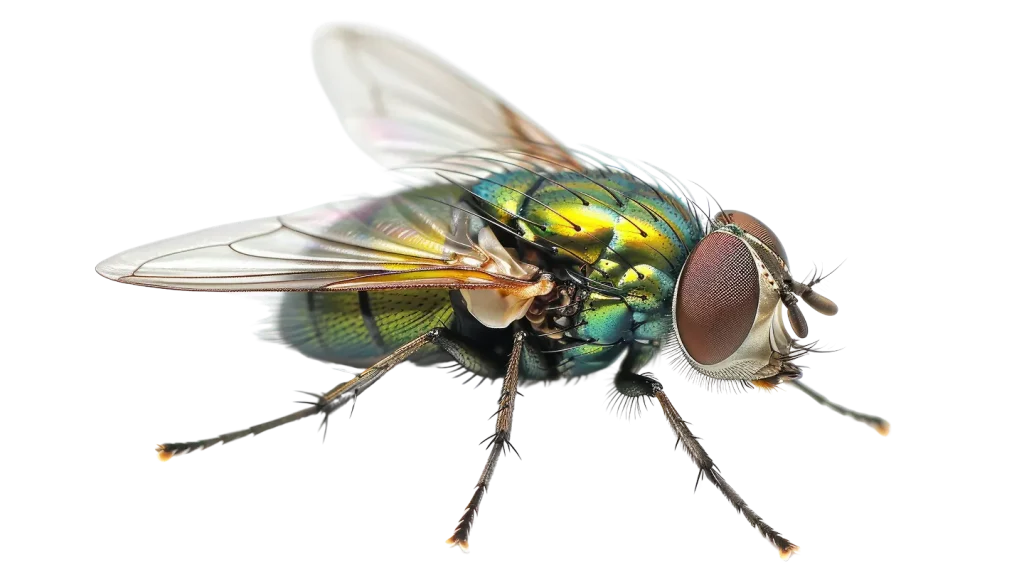
FLY
Common Name: House Fly
Size: 4 to 7 mm long
Life Span: 15 to 30 days
Houseflies are among the most widespread insects, thriving in environments where food and waste are readily available. They are commonly found in homes, restaurants, markets, and garbage dumps. These insects are highly mobile, capable of flying long distances in search of food and breeding sites. Warm temperatures accelerate their life cycle, allowing them to reproduce quickly. A single female can lay up to 500 eggs in her lifetime, usually in decaying organic matter such as garbage, animal waste, or compost. Within a day, the eggs hatch into larvae (maggots), which feed on decomposing material before pupating into adult flies.
Houseflies have sponge-like mouthparts and feed by liquefying food with their saliva. Since they cannot chew, they primarily consume sugary or semi-liquid substances. Their rapid movement and strong flight abilities make them difficult to catch or control. Unlike many insects, they do not have a stinger or venom, but their constant contact with filth makes them one of the most problematic pests. They are most active during the daytime and tend to rest on ceilings, walls, and other surfaces when not feeding. Their attraction to food, moisture, and waste makes them persistent invaders in human spaces.
As pest
Flies are notorious for spreading diseases due to their habit of landing on garbage, faeces, and decaying matter before contaminating food and surfaces. Their bodies and legs carry bacteria, viruses, and parasites, which they transfer through direct contact or their excretions. They are known to spread illnesses such as dysentery, typhoid, cholera, and food poisoning. Since they constantly regurgitate saliva while feeding, they introduce germs into whatever they consume.
In addition to being carriers of disease, their rapid reproduction makes infestations difficult to control. Flies are also a major nuisance, swarming around food, buzzing indoors, and laying eggs in waste. Their presence in kitchens and dining areas is not just unhygienic but can also damage a business’s reputation. In agricultural settings, they affect livestock by spreading infections that impact animal health. Unlike other pests that hide in dark corners, flies are highly visible, making them an immediate concern for homeowners and businesses. Signs of an infestation include clusters of flies around food sources, dark spots of excrement on walls, and an increase in maggots in trash bins or organic waste. Since they multiply quickly, delaying action can result in a persistent and widespread problem.

How to control
Preventing fly infestations requires a combination of sanitation, exclusion, and targeted control measures. Keeping living spaces clean by regularly disposing of garbage, sealing trash bins, and maintaining proper food storage reduces their access to food and breeding sites. Since flies breed in moist organic matter, cleaning drains, removing pet waste, and ensuring compost is properly covered help minimize infestations. Installing mesh screens on doors and windows prevents them from entering indoor spaces. Sticky traps, UV light traps, and flypaper can help reduce their numbers, especially in kitchens and dining areas.
Chemical solutions like insecticide sprays or bait stations provide temporary relief, but their effectiveness depends on proper placement and application. Biological control methods, such as introducing natural predators like parasitic wasps, are also used in outdoor environments. Regular maintenance, such as fixing leaks and cleaning up spills promptly, discourages flies from settling indoors. Since flies are highly adaptable, controlling them requires consistency. Even after reducing their numbers, ongoing preventive efforts are necessary to keep them from returning. By maintaining cleanliness and eliminating breeding grounds, it becomes much easier to manage fly populations and prevent future infestations.

